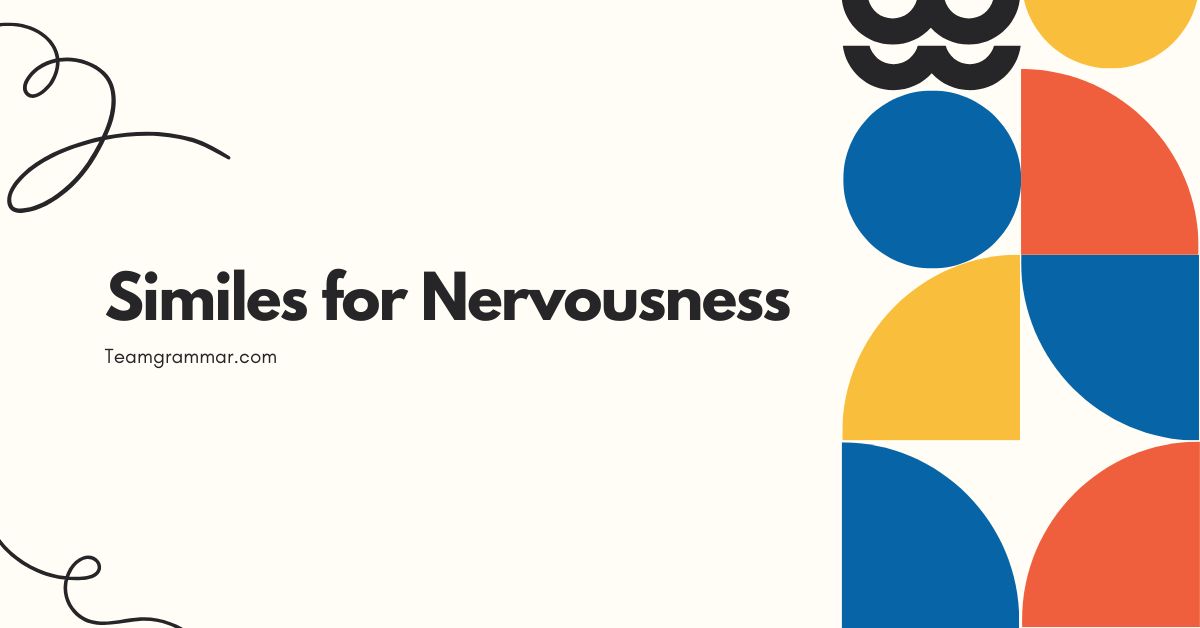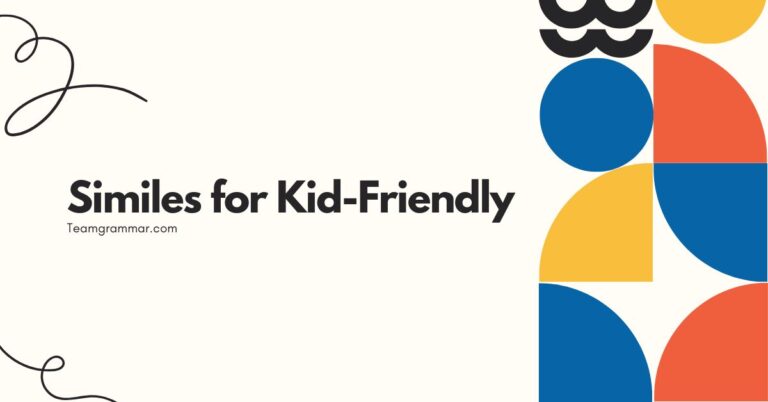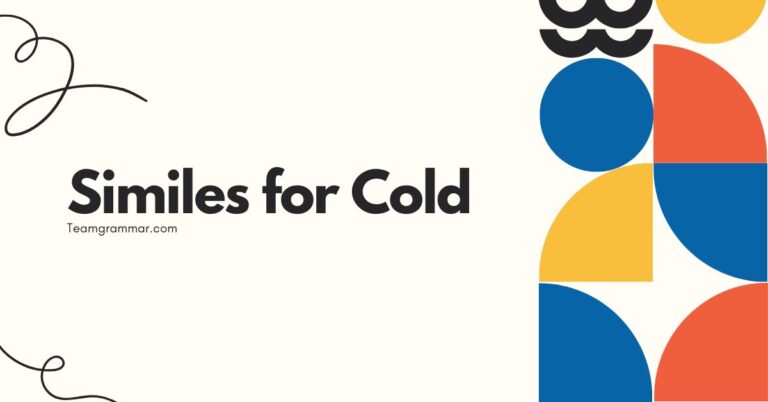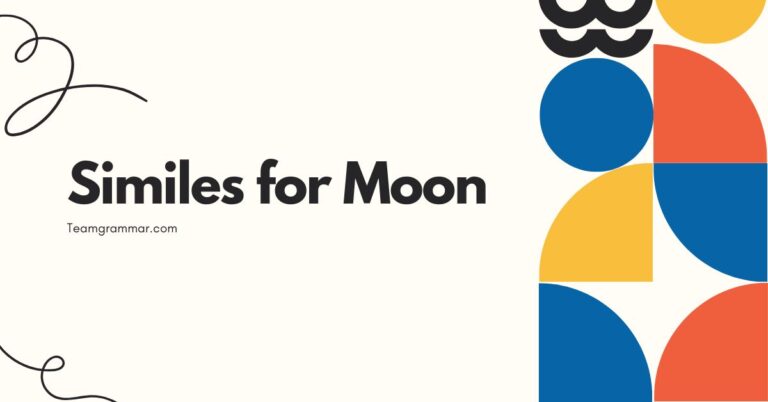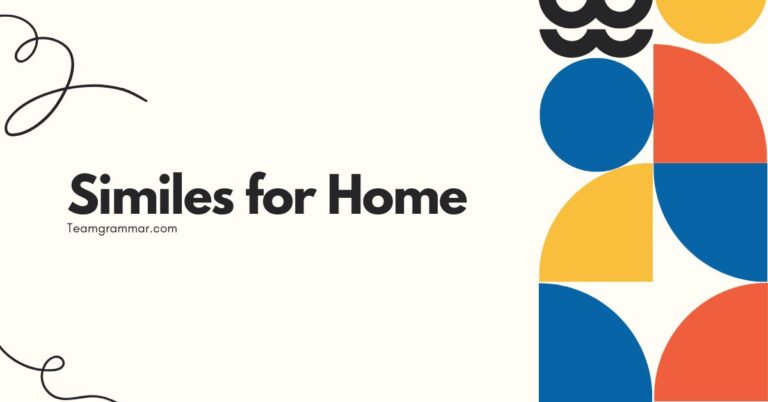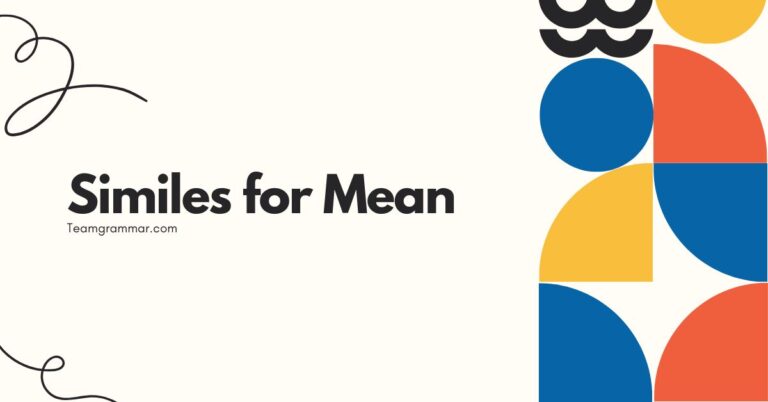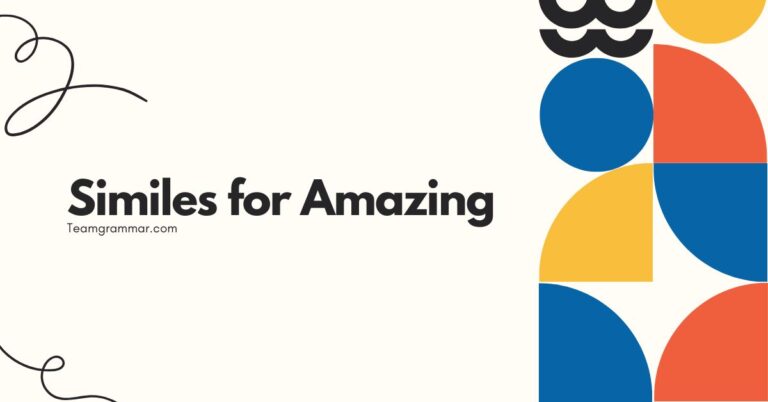45 Similes for Nervousness: A Comprehensive Guide
Understanding how to effectively use similes to describe nervousness can significantly enhance your writing and speaking skills. Similes provide a vivid and relatable way to express the feeling of anxiety, making your descriptions more engaging and impactful.
This article explores various similes that capture the essence of nervousness, offering a detailed breakdown of their usage, structure, and context. Whether you’re a student, writer, or language enthusiast, this guide will equip you with the tools to articulate nervousness with precision and creativity.
Table of Contents
- Introduction
- Definition of Simile and Nervousness
- Structural Breakdown of Nervousness Similes
- Types of Nervousness and Corresponding Similes
- Examples of Similes for Nervousness
- Usage Rules for Similes
- Common Mistakes When Using Similes
- Practice Exercises
- Advanced Topics in Simile Usage
- Frequently Asked Questions
- Conclusion
Definition of Simile and Nervousness
Asimileis a figure of speech that compares two unlike things using “like” or “as.” It’s a powerful tool for creating vivid imagery and conveying emotions effectively. Similes help bridge the gap between abstract feelings and concrete concepts, making it easier for the audience to understand and connect with the described experience.
They enhance descriptive writing by adding depth and color to the narrative.
Nervousness, on the other hand, is a state of unease or anxiety, often experienced before an important event or in stressful situations. It involves a complex interplay of psychological and physiological responses, including increased heart rate, sweating, and feelings of apprehension.
Describing nervousness accurately requires more than just stating the feeling; it involves capturing the physical and emotional manifestations of this state.
Structural Breakdown of Nervousness Similes
The basic structure of a simile is as follows:A (the subject being described) + is like/as + B (the object used for comparison). When crafting similes for nervousness, ‘A’ represents the person or their state of being nervous, and ‘B’ is something that embodies or reflects that feeling.
The effectiveness of a simile lies in the aptness of the comparison; the more relatable and vivid the ‘B’ is, the more impactful the simile becomes. For example, “He was as nervous as a long-tailed cat in a room full of rocking chairs” effectively conveys the character’s anxiety through a humorous and easily visualized image.
The comparison using “like” or “as” must highlight a shared quality between the subject and the object. This shared quality is what makes the simile resonate with the audience.
In the context of nervousness, this shared quality might be instability, agitation, or a sense of being overwhelmed. Similes can also incorporate sensory details to enhance their impact, such as “My hands were as cold as ice, like the grip of fear itself.”
Types of Nervousness and Corresponding Similes
Nervousness is not a monolithic emotion; it can manifest in various forms depending on the situation. Understanding these different types can help you choose the most appropriate and effective similes.
Anticipatory Nervousness
This type of nervousness occurs before an event, driven by the anticipation of what might happen. It’s often characterized by restlessness, worry, and a sense of impending doom.
Similes for anticipatory nervousness often involve images of waiting, uncertainty, and vulnerability.
Performance Nervousness
Performance nervousness is specifically related to the anxiety felt before or during a performance, whether it’s a speech, a presentation, or an athletic event. It’s marked by physical symptoms like trembling, sweating, and a racing heart.
Similes for performance nervousness often focus on the body’s reaction to stress and the pressure to succeed.
Social Nervousness
Social nervousness arises in social situations, often due to fear of judgment or rejection. It can lead to shyness, self-consciousness, and a desire to avoid social interactions.
Similes for social nervousness often depict feelings of isolation, vulnerability, and a heightened awareness of oneself.
General Anxiety
General anxiety is a more pervasive and chronic form of nervousness, characterized by excessive worry about everyday events. It can interfere with daily life and lead to physical symptoms like fatigue and muscle tension.
Similes for general anxiety often convey a sense of being constantly on edge, overwhelmed, and unable to relax.
Examples of Similes for Nervousness
Here are some examples of similes that effectively describe nervousness, categorized by the type of nervousness they represent. These examples are designed to provide inspiration and demonstrate the versatility of similes in conveying this complex emotion.
Table 1: Similes for Anticipatory Nervousness
| Simile | Explanation |
|---|---|
| As nervous as a cat on a hot tin roof. | Implies extreme restlessness and discomfort due to an impending event. |
| Like a ticking time bomb, waiting to explode with anxiety. | Suggests a build-up of tension and the fear of an imminent outburst. |
| As jittery as a hummingbird before a storm. | Conveys a sense of frantic energy and unease in anticipation of something bad. |
| He felt like a tightrope walker without a net. | Describes the vulnerability and high stakes associated with an upcoming challenge. |
| As apprehensive as a student awaiting exam results. | Highlights the worry and uncertainty of waiting for an important outcome. |
| She was as anxious as a child lost in a crowded market. | Illustrates the feeling of being overwhelmed and vulnerable in an uncertain situation. |
| He felt like a runner poised at the starting line, heart pounding. | Captures the intense anticipation and physical tension before a race. |
| As uneasy as a witness about to testify. | Conveys the apprehension and pressure of facing scrutiny. |
| She was like a coiled spring, ready to snap. | Suggests pent-up tension and the potential for an emotional breakdown. |
| He felt like a mouse cornered by a cat. | Describes the feeling of being trapped and helpless in a threatening situation. |
| As restless as a caged bird longing to fly. | Implies a desire to escape the source of anxiety and find freedom. |
| She was like a ship caught in a storm, tossed and turned by worry. | Conveys the feeling of being overwhelmed and out of control due to anxiety. |
| He felt like a soldier waiting for the battle to begin. | Captures the fear and anticipation of facing a difficult challenge. |
| As tense as a drawn bowstring, ready to release. | Suggests a build-up of tension and the potential for a sudden release. |
| She was like a climber hanging from a cliff, struggling to hold on. | Illustrates the feeling of being on the verge of collapse due to stress. |
| He felt like a diver about to plunge into the unknown depths. | Conveys the fear and uncertainty of facing an unfamiliar situation. |
| As shaky as a leaf in a hurricane, tossed violently by the wind. | Implies a feeling of being powerless and at the mercy of overwhelming forces. |
| She was like a prisoner awaiting her sentence, dreading the outcome. | Captures the fear and hopelessness of facing an uncertain future. |
| He felt like an actor waiting in the wings, about to step onto the stage. | Describes the anticipation and nervousness of facing an audience. |
| As jumpy as a frog on a lily pad, ready to leap at any moment. | Suggests a heightened state of alertness and the potential for a sudden reaction. |
| She was as nervous as a new driver on their first solo trip. | Illustrates the feeling of being inexperienced and unsure in a challenging situation. |
| He felt like a tightrope walker without a net. | Describes the vulnerability and high stakes associated with an upcoming challenge. |
| She was as anxious as a child lost in a crowded market. | Illustrates the feeling of being overwhelmed and vulnerable in an uncertain situation. |
The similes in Table 1 highlight the feeling of unease and anticipation that comes before an event by comparing it to relatable scenarios.
Table 2: Similes for Performance Nervousness
| Simile | Explanation |
|---|---|
| His hands were as clammy as a fish. | Describes the physical symptom of sweaty hands due to nervousness. |
| Like a deer in headlights, frozen with fear on stage. | Suggests being overwhelmed and unable to react due to stage fright. |
| As shaky as a newborn foal trying to stand. | Conveys a sense of instability and lack of confidence during a performance. |
| She felt like her voice was a rusty hinge, creaking with every word. | Describes the difficulty and strain of speaking due to nervousness. |
| He was as stiff as a board, unable to move naturally. | Highlights the physical tension and rigidity caused by performance anxiety. |
| Like a marionette with tangled strings, his movements were jerky and uncontrolled. | Suggests a lack of control over one’s body due to nervousness. |
| Her heart was pounding like a drum solo in a rock concert. | Conveys the intense physical sensation of a racing heart. |
| He felt like his mind was a blank canvas, devoid of ideas. | Describes the mental block and inability to think clearly during a performance. |
| As dry as the Sahara, his mouth felt parched and unable to speak. | Highlights the physical symptom of a dry mouth due to nervousness. |
| She was like a robot programmed to fail, making mistakes at every turn. | Suggests a self-fulfilling prophecy of failure due to performance anxiety. |
| He felt like his legs were made of jelly, unable to support him. | Describes the physical sensation of weak and unsteady legs. |
| As fragile as glass, she felt like she would shatter under the pressure. | Conveys the feeling of vulnerability and emotional fragility. |
| He was like a wind-up toy running out of steam, slowing down and faltering. | Suggests a loss of energy and motivation during a performance. |
| As tangled as a ball of yarn, his thoughts were confused and disorganized. | Highlights the mental disarray and difficulty in concentrating. |
| She felt like she was walking on eggshells, afraid to make a wrong move. | Describes the feeling of being overly cautious and afraid of making mistakes. |
| He was like a broken record, repeating the same mistakes over and over. | Suggests a pattern of errors due to performance anxiety. |
| As exposed as a spotlight, she felt like everyone was watching her flaws. | Conveys the feeling of being under intense scrutiny and judgment. |
| He felt like he was drowning in a sea of expectations, struggling to stay afloat. | Describes the overwhelming pressure to succeed. |
| As tight as a drum, his muscles were tense and constricted. | Highlights the physical tension and stiffness caused by performance anxiety. |
| She was like a puppet on a string, her movements controlled by her nervousness. | Suggests a loss of control over one’s body due to anxiety. |
| He felt like he was running a marathon with a broken leg. | Illustrates the feeling of struggling against overwhelming odds. |
| As brittle as autumn leaves, she felt like she would crumble under pressure. | Conveys the feeling of vulnerability and emotional fragility. |
| He was like a malfunctioning robot, his actions erratic and unpredictable. | Suggests a loss of control over one’s behavior due to anxiety. |
Table 2 provides similes that capture the physical and mental manifestations of performance nervousness, such as clammy hands, a racing heart, and difficulty speaking.
Table 3: Similes for Social Nervousness
| Simile | Explanation |
|---|---|
| Like a wallflower at a dance, she stood alone and unnoticed. | Describes the feeling of isolation and invisibility in a social setting. |
| As awkward as a penguin on land, he struggled to navigate social interactions. | Conveys a sense of clumsiness and discomfort in social situations. |
| She felt like an alien in a foreign land, unable to understand the social cues. | Suggests a feeling of being out of place and unable to connect with others. |
| He was as quiet as a mouse, afraid to draw attention to himself. | Highlights the shyness and fear of being noticed. |
| Like a chameleon, she tried to blend into the background, avoiding eye contact. | Describes the attempt to become invisible and avoid social interaction. |
| He felt like he was wearing a mask, hiding his true self from others. | Suggests a feeling of inauthenticity and the need to conceal one’s true feelings. |
| As uncomfortable as a sweater made of sandpaper, he couldn’t relax in social situations. | Conveys a sense of constant irritation and discomfort. |
| She was like a puzzle piece that didn’t fit, feeling out of place and unwanted. | Describes the feeling of not belonging and being excluded. |
| He felt like he was walking through a minefield, afraid to say the wrong thing. | Suggests a fear of making social mistakes and being judged. |
| As transparent as glass, she felt like everyone could see her insecurities. | Conveys the feeling of vulnerability and exposure. |
| He was like a satellite orbiting a distant planet, observing social interactions from afar. | Describes the feeling of being detached and disconnected from others. |
| As lost as a tourist without a map, she felt overwhelmed by the social landscape. | Suggests a feeling of confusion and disorientation in social situations. |
| He felt like he was speaking a different language, unable to communicate effectively. | Describes the difficulty in connecting with others and expressing oneself. |
| As isolated as an island, she felt cut off from the rest of the world. | Conveys a strong sense of loneliness and isolation. |
| He was like a scarecrow in a field, standing alone and ignored. | Suggests a feeling of being unwanted and overlooked. |
| As muted as a silent film, she felt like her voice was unheard and unimportant. | Describes the feeling of being ignored and unable to express oneself. |
| He felt like he was trapped in a glass box, watching social interactions from the outside. | Suggests a feeling of being disconnected and unable to participate. |
| As invisible as a ghost, she felt like she didn’t exist in the social setting. | Conveys a strong sense of invisibility and insignificance. |
| He was like a broken radio, unable to receive or transmit social signals. | Suggests a difficulty in understanding and responding to social cues. |
| As frozen as a statue, she felt unable to move or speak in social situations. | Describes the physical and emotional paralysis caused by social anxiety. |
| He felt like he was walking on thin ice, afraid to make a wrong move. | Suggests a fear of making social mistakes and being judged. |
| As silent as a tomb, the room felt heavy with unspoken expectations. | Conveys a sense of tension and unease in a social setting. |
The similes in Table 3 illustrate the feeling of discomfort and isolation often experienced in social situations, capturing the essence of social nervousness.
Table 4: Similes for General Anxiety
| Simile | Explanation |
|---|---|
| Like a constant hum in the background, anxiety never truly faded away. | Describes the persistent and underlying nature of general anxiety. |
| As heavy as a lead weight, anxiety dragged her down and made it hard to move. | Conveys the feeling of being burdened and weighed down by anxiety. |
| She felt like she was drowning in a sea of worries, struggling to stay afloat. | Suggests the overwhelming nature of anxiety and the constant struggle to cope. |
| He was as tense as a coiled spring, always on edge and ready to snap. | Highlights the constant state of tension and the potential for an emotional outburst. |
| Like a never-ending storm, anxiety raged within her, disrupting her peace. | Describes the turbulent and disruptive nature of anxiety. |
| He felt like he was running on a treadmill, constantly moving but getting nowhere. | Suggests the feeling of being trapped in a cycle of worry and anxiety. |
| As dark as a shadow, anxiety followed her everywhere she went. | Conveys the constant presence and pervasive nature of anxiety. |
| She was like a broken record, repeating the same worries over and over again. | Describes the repetitive and intrusive nature of anxious thoughts. |
| He felt like he was trapped in a maze, unable to find a way out of his anxiety. | Suggests the feeling of being lost and unable to escape from anxious thoughts. |
| As sharp as a knife, anxiety cut through her peace and left her feeling wounded. | Conveys the painful and damaging effects of anxiety. |
| He was like a prisoner in his own mind, trapped by his anxious thoughts. | Suggests the feeling of being confined and controlled by anxiety. |
| As relentless as a storm, anxiety battered her mind and body. | Describes the persistent and damaging effects of anxiety. |
| He felt like he was walking on a tightrope, constantly afraid of falling. | Suggests the feeling of being constantly on edge and vulnerable. |
| As suffocating as a blanket, anxiety smothered her joy and enthusiasm. | Conveys the feeling of being overwhelmed and unable to breathe. |
| He was like a broken compass, unable to find his way in life due to anxiety. | Suggests the feeling of being lost and directionless. |
| As crippling as a disability, anxiety prevented her from living a full life. | Conveys the limiting and disabling effects of anxiety. |
| He felt like he was carrying the weight of the world on his shoulders, burdened by anxiety. | Suggests the overwhelming feeling of responsibility and worry. |
| As consuming as a fire, anxiety burned through her energy and motivation. | Conveys the draining and destructive effects of anxiety. |
| He was like a ship without an anchor, drifting aimlessly on a sea of anxiety. | Suggests the feeling of being lost and without direction. |
Table 4 offers similes that capture the pervasive and chronic nature of general anxiety, highlighting its impact on daily life and well-being.
Usage Rules for Similes
When using similes, it’s important to ensure they are both accurate and effective. Here are some key rules to follow:
- Clarity: The comparison should be clear and easy to understand. Avoid obscure or overly complex references.
- Relevance: The two things being compared should share a relevant quality. The comparison should make logical sense.
- Originality: While clichés can be tempting, strive for originality. Fresh and unexpected similes are more impactful.
- Context: The simile should fit the tone and style of your writing. Consider the audience and the overall message.
- Avoid Overuse: Similes can be powerful, but overuse can diminish their impact. Use them sparingly and strategically.
Common Mistakes When Using Similes
Several common mistakes can weaken the effectiveness of similes. Being aware of these pitfalls can help you avoid them.
Table 5: Common Mistakes with Similes
| Mistake | Incorrect Example | Correct Example | Explanation |
|---|---|---|---|
| Using clichés | He was as nervous as a cat. | He was as nervous as a long-tailed cat in a room full of rocking chairs. | Avoid overused similes that lack originality. |
| Illogical comparisons | She was as nervous as a tree. | She was as nervous as a leaf trembling on a tree. | Ensure the comparison is logical and shares a relevant quality. |
| Overly complex similes | He was as nervous as the quantum entanglement of two subatomic particles. | He was as nervous as a student awaiting exam results. | Keep the comparison clear and easy to understand. |
| Inappropriate tone | She was as nervous as a clown at a funeral. | She was as nervous as a bride walking down the aisle. | Ensure the simile fits the tone and style of your writing. |
Practice Exercises
Test your understanding of similes for nervousness with these exercises. Choose the best simile to complete each sentence, or create your own.
Exercise 1: Fill in the Blanks
| Question | Answer |
|---|---|
| 1. Before the presentation, he was _____________. | As nervous as a cat on a hot tin roof. |
| 2. Her hands were _______________ as she waited for the results. | As clammy as a fish. |
| 3. In the crowded room, she felt _______________. | Like a wallflower at a dance. |
| 4. His anxiety was _______________, never truly fading away. | Like a constant hum in the background. |
| 5. Waiting for the interview, he felt _______________. | Like a tightrope walker without a net. |
| 6. On stage, she was _______________, frozen with fear. | Like a deer in headlights |
| 7. At the party, he felt _______________, struggling to connect. | As awkward as a penguin on land. |
| 8. Her worries were _______________, repeating over and over. | Like a broken record. |
| 9. Before the big game, he was _______________. | As jumpy as a frog on a lily pad. |
| 10. In the unfamiliar city, she felt _______________. | As lost as a tourist without a map. |
Exercise 2: Create Your Own Similes
- Describe the feeling of anticipatory nervousness before a job interview.
- Describe the physical sensations of performance nervousness during a speech.
- Describe the feeling of social nervousness at a party where you don’t know anyone.
- Describe the experience of general anxiety on a day-to-day basis.
- Describe the feeling of nervousness before a first date.
Advanced Topics in Simile Usage
For advanced learners, exploring the nuances of simile usage can elevate your writing to a higher level. Consider the following:
- Extended Similes: Develop a simile over several sentences or paragraphs for greater impact.
- Metaphor vs. Simile: Understand the difference and when to use each for maximum effect.
- Cultural Context: Be aware of how cultural references can influence the understanding of your similes.
- Subverting Expectations: Use unexpected or ironic similes to create surprise and humor.
Frequently Asked Questions
- What is the difference between a simile and a metaphor?
A simile explicitly compares two things using “like” or “as,” while a metaphor implies a comparison without using these words. For example, “He is like a lion” (simile) vs. “He is a lion” (metaphor).
- How can I make my similes more original?
Avoid clichés and think outside the box. Consider unusual or unexpected comparisons that still share a relevant quality with the subject.
- Is it okay to use similes in formal writing?
Yes, but use them sparingly and ensure they are appropriate for the tone and style of the writing. Avoid overly informal or humorous similes in formal contexts.
- How many similes should I use in a piece of writing?
There is no fixed rule, but avoid overuse. Too many similes can make your writing feel cluttered and detract from their impact. Use them strategically and purposefully.
- Can a simile be too complex?
Yes, a simile should be clear and easy to understand. Avoid obscure or overly technical references that might confuse the reader.
- What if I can’t think of a good simile?
Don’t force it. Sometimes, a direct description is more effective than a weak or contrived simile. Focus on conveying the feeling or image clearly.
- How do I know if my simile is effective?
Ask for feedback from others. If they understand the comparison and it evokes the intended feeling or image, then it’s likely effective.
- Are there any cultures where similes are used differently?
Yes, different cultures may have different preferences for simile usage and may interpret comparisons differently based on their cultural context. Be mindful of your audience when using similes across cultures.
- Can I use similes to describe abstract concepts?
Absolutely. Similes are excellent for making abstract concepts more understandable by comparing them to concrete things. This is especially useful when describing emotions like nervousness.
- How can I practice using similes more effectively?
Write regularly, experiment with different comparisons, and pay attention to how other writers use similes. The more you practice, the better you’ll become at crafting effective similes.
Conclusion
Mastering the use of similes to describe nervousness can significantly enhance your ability to convey emotions and create vivid imagery in your writing. By understanding the structure, types, and usage rules of similes, you can effectively articulate the nuances of anxiety in various contexts.
Remember to strive for originality, clarity, and relevance in your comparisons, and avoid common mistakes like clichés and illogical associations. Practice using similes regularly, and seek feedback to refine your skills.
With consistent effort, you can harness the power of similes to bring your writing to life and connect with your audience on a deeper level.

